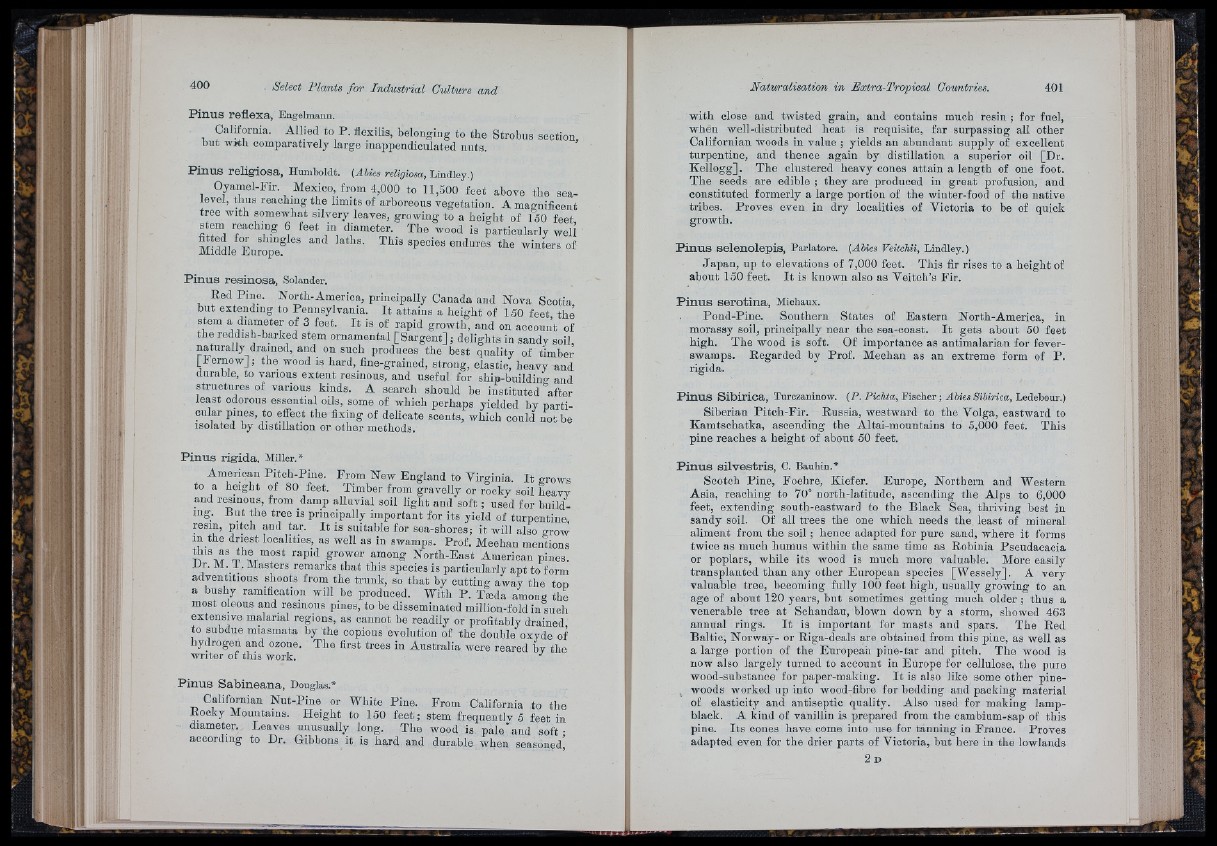
P i n u s r e fle x a , Engelmann.
California. Allied to P. flexilis, belonging to the Strobus section,
but W ith comparative^ large inappendioiilated nuts.
P i n u s r e lig io s a , Humboldt. (Abies religiosa, JAadley.)
Oyamel-Fir. Mexico, from 4,000 to 11,500 feet above tbe sealevel,
thus reaching the limits of arboreous vegetation. A magnificent
tree with somewhat silvery leaves, growing to a height of 150 feet
stem reaching 6 feet in diameter. The wood is particulariy well
7 Z Tbis species endures the winters of
MiddJe Europe.
P i n u s r e s in o s a , Solander.
Bed Pine. North-America, principally Canada aud Nova Scotia
but extending to Pennsylvania. I t attains a height of 150 feet thè
stem a diameter of 3 feet. I t is of rapid growth, aud on account of
the redffish-barked stem ornamental [Sargent] ; delights in sandy soil
naturally drained, and on such produces the best quality of timber
[Pern ow]; the wood is hard, fine-grained, strong, elastic, heavy and
durable, to various exteiH resinous, aud useful for ship-building and
structures of various kinds. A search should be instituted after
least odorous essential oils, some of which perhaps yielded by particular
pines, to effect the fixing of delicate scents, which could not be
isolated by distillation or other methods.
P i n u s r ig id a . Miller.*
American Pitch-Pine. From New England to Virginia. I t grows
to a height of 80 feet. Timber from gravelly or rocky soil heavy
and resinous, from damp alluvial soil light and soft ; used for building.
But the tree is principally important for its yield of turpentine
resin, pitch and tar. I t is suitable for sea-shores; it will also orow
in the driest localities, as well as in swamps. Prof. Meehan mentions
grower among North-East American pines.
IJr. M. I . Masters remarks th a t this species is particulariy apt to form
adventitious shoots from the trunk, so th a t by cutting away the top
a bushy ramification will be produced. With P . T®da among the
most oleous and resinous pines, to be disseminated million-fold in sucli
extensive mffiarial regions, as cannot be readily or profitably drained
to subdue miasmata by the copious evolution of the double oxyde of
hydrogen and ozone. The first trees in Australia were reared bv the
writer of tbis work.
P i n u s S a b in e a n a , Douglas *
Californian Nut-Pine or White Pine. From California to the
Rocky Mountains. Height to 150 fe e t; stem frequent!v 5 feet in
diameter. Leaves unusually long. The wood is pale "and soft ■
according to Dr. Gibbons it is hard and durable when seasoned’
with close and twisted grain, and contains much resin ; for fuel,
when well-distributed heat is requisite, far surpassing all other
Californian woods in value ; yields an abundant supply of excellent
turpentine, and thence again by distillation a superior oil [Dr.
Kellogg]. The clustered heavy cones attain a length of one foot.
The seeds are edible ; they are produced in great profusion, and
constituted formerly a large portion of the winter-food of the native
tribes. Proves even in dry localities of Victoria to be of quick
growth.
P i n u s s e le n o le p is , Parlatore. (Abies Veitchii, Lindley.)
J apan, up to elevations of 7,000 feet. This fir rises to a height of
about 150 feet. I t is known also as Veitoh’s Fir.
P i n u s s e r ó t in a , Michaux.
Pond-Pine. Southern States of Eastern North-Amerioa, in
morassy soil, principally near the sea-coast. I t gets about 50 feet
high. The wood is soft. Of importance as antimalarian for fever-
swamps. Regarded by Prof. Meehan as an extreme form of P.
rigida.
P i n u s S ib ir io a , Turczaninow. (P. Pichta, Fischer ; Ahies Sibirica, Ledebour.)
Siberian Pitch-Fir. Russia, westward to the Volga, eastward to
Kamtschatka, ascending the Altai-mountains to 5,000 feet. This
pine reaches a height of about 50 feet.
P i n u s s i lv e s tr i s , C. Bauhin.*
Scotch Pine, Foehre, Kiefer. Europe, Northern and Western
Asia, reaching to 70° north-latitude, ascending the Aljis to 6,000
feet, extending south-eastward to the Black Sea, thriving best in
sandy soil. Of all trees the one which needs the least of mineral
aliment from the so il; hence adapted for pure sand, where it forms
twice as much humus within the same time as Eobinia Pseudacacia
or poplars, while its wood is much more valuable. More easily
transplanted than any other European species [Wessely]. A very
valuable tree, becoming fully 100 feet high, usually growing to an
age of about 120 years, but sometimes getting much older ; thus a
venerable tree at Schandau, blown down by a storm, showed 463
annual rings. I t is important for masts and spars. The Red
Baltic, Norway- or Riga-deals are obtained from this pine, as well as
a large portion of the European pine-tar and pitch. The wood is
now also largely turned to account in Europe for cellulose, the pure
wood-substance for paper-making. I t is also like some other pine-
, woods worked up into wood-fibre for bedding and packing material
of elasticity and antiseptic quality. Also used for making lampblack.
A kind of vanillin is prepared from tbe cambium-sap of this
pine. Its cones have come into use for tanning in France. Proves
adapted even for the drier parts of Victoria, but here in the lowlands